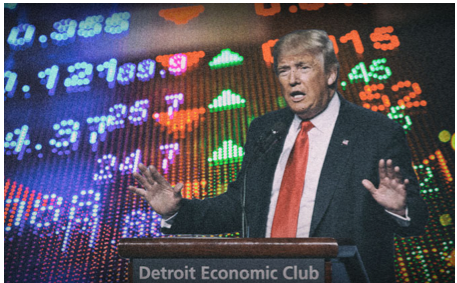
The U.S. economy is experiencing its most prolonged period of expansion since the postwar period (39 consecutive quarters of growth, exceeding the 36 quarters of the early 1960s). The level of activity surpasses what economists consider a “maximum sustainable level.” The unemployment rate (3.6%) is the lowest since July 1969, and the use of installed capacity is close to its historical maximum.
Despite all these factors, the inflation rate remains below the 2% annual target, and wages are growing moderately. This is the first big puzzle: Why do salaries grow moderately with such a low unemployment rate? The answer lies in the type of employment being created.
The economy already showed solid indicators when the last presidential election was held, but despite this, candidate Donald Trump expressed dissatisfaction on three points: a) imbalance in external accounts; b) the number of people outside the labor market (which he attributed to the “disillusionment” of not being able to find a job); and c) the growth rate, which he considered way below its historical values and the true potential of the U.S.
A superficial evaluation of the data would seem to prove him right: The imbalance in the balance of payments at that time exceeded $450 billion (2.3% of the gross domestic product), there were more than 2 million people who had given up looking for jobs, and the average GDP growth rate during this last expansion cycle was half that recorded in the previous expansive cycle in the 1960s.
Once elected, Trump dedicated himself to attacking these “problems,” focusing solutions on three actions: lowering taxes, taking commercial reprisals against several countries (to reverse what he considered “unfair behavior” in international commerce and as a mechanism to increase employment) and restricting illegal migration.
In fact, a more detailed analysis shows that the ratio of external deficit to the GDP was already half of that registered in 2008 and that the remaining imbalance was a reflection of the lack of “an international currency,” which forced countries to deliver goods in exchange for “slips of paper” to meet their liquidity needs. The analysis also showed that the drop in the U.S. growth rate was more associated with the population’s “aging” problems (lower growth of labor supply and decline in savings rate) than with investment incentive issues (although these were important), because the incorporation of the “disillusioned” into the labor market would not solve these problems. And the analysis further showed that restrictions on migration and trade could distort the functioning of the labor market.
Results of these policies have been mixed thus far. The unemployment rate has continued to fall, and the market has absorbed a marginal portion of the “disillusioned,” external imbalances have grown instead of diminishing, growing commercial tensions are affecting international trade (lowering imports but also exports), and finally, tax cuts have been reflected in an increase in the investment rate but are doubling the fiscal deficit.
The huge deterioration of the fiscal imbalance is generating another paradigm: its financing requires debt issuance in circumstances where major buyers of foreign bonds (China and Japan) are not doing so and the Federal Reserve is reducing its bond holdings. Higher supply accompanied by lower demand should normally be reflected in a drop in the price of bonds (and a rise in the interest rate), but the exact opposite is happening. This is the second great enigma of the U.S. economy.
The list of debt holders allows for the solution to this riddle. Major buyers of bonds were other foreigners (funds were leaving emerging countries frightened by the possible effects of the trade war), and in particular, U.S. families that doubled their bond holdings when traditionally they were not bond buyers. How did they do it? Using the higher available income from tax cuts to save instead of consume. This behavior is similar to that of the Japanese following the great crisis of the early 1990s.
The counterpart of the families’ actions is controlling expenditure growth. The latest figures show that the acceleration of the growth rate in the first quarter is almost totally explained by the accumulation of stocks (companies sold less than anticipated) but that consumption and investments show significant deceleration.
The big question for the future is, will families continue to devote a major portion of their income to savings and buying bonds? If the answer is yes, we will see an economic slowdown accompanied by low rates. If the answer is no, we will witness an increase in consumption accompanied by a rate increase. A worsening of the trade war would make the decision of families even more difficult.

Leave a Reply
You must be logged in to post a comment.